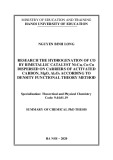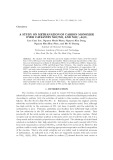
CO hydrogenation reaction
-
Bài giảng "Hóa hữu cơ 1" Chương 8 - Alkene – Phản ứng và tổng hợp, được biên soạn gồm các nội dung chính sau: Điều chế alkene: phản ứng tách (elimination reaction); Halogen hóa alkene: phản ứng cộng X2; Halohydrin từ alkene: phản ứng cộng HO-X; Phản ứng cộng H2O xúc tác bởi acid (hydration);...Mời các bạn cùng tham khảo!
 49p
49p  laphongtrang0906
laphongtrang0906
 03-04-2025
03-04-2025
 4
4
 2
2
 Download
Download
-
Research purpose: Using computational chemistry methods to study the mechanism of hydrogenation CO on the transition metal catalyst systems of Ni, Cu, Co, bimetallic catalysts NiCu, CoCu and catalytic systems bearing cluster on oxide carriers: MgO, Al2O3 and activated carbon (AC); compare and clarify the role of catalyst centers in single or bimetallic catalyst systems; clarifies the role of carriers (MgO, Al2O3 and AC) in the hydrogenation of CO.
 27p
27p  thebadguys
thebadguys
 08-06-2021
08-06-2021
 31
31
 4
4
 Download
Download
-
The catalyst 7.5% NiO/TiO2 and seven samples of NiO/γ-Al2O3 with NiO content from 7.5% to 60% have been obtained and studied. Physico-chemical characteristics of the catalysts were determined by methods of Adsorption (BET), X-ray Diffraction (XRD), TemperatureProgrammed Reduction (TPR) and Hydrogen Pulse Titration. The catalytic properties of the obtained samples were investigated in the reaction of CO methanation at temperatures 180 – 220◦C and mole ratios hydrogen/carbon monoxide 25-100.
 16p
16p  12120609
12120609
 01-06-2020
01-06-2020
 11
11
 1
1
 Download
Download













